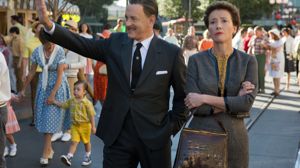You might have grown up in a Disney Family, but some of us did not. I haven't even seen all of Mary Poppins _in one sitting, only in accumulated snippets over decades. This, is, I think, unusual, and so I come to all things Disney with a decidedly outsider point of view. The whole Disney experience--movies, TV shows, or theme parks*--is so carefully curated, so perfect, that I can't fully buy into it. In this sense, I found myself completely aligned with author P. L. Travers in _Saving Mr. Banks.
And it's specialists like you, Thomas, who are precisely the reason. Let me try to explain why.
Saving Mr. Banks _chronicles a two-week period in which Travers (Emma Thompson) travelled to Los Angeles to oversee the adaptation of her book _Mary Poppins into the beloved film._ _Travers is fiercely protective of her work, and does not trust that Walt Disney (Tom Hanks) and his creative team will maintain her original vision, and instead turn it into one of his "silly cartoons." I found it easy to see her reasoning.
Interweaved throughout are flashbacks to Travers' childhood, focusing on the relationship she had with her alcoholic father, Travers Goff (Colin Farrell). This experience is central to her formation: Goff continually encourages the young Travers' imagination and love of fantasy, but is also an example of what can happen when you lose control of your own destiny. It's not only Travers' book and characters that she's curating, but her entire persona. She has reasons to be protective.
But back to you. Here's a film production, Saving Mr. Banks, where it was deemed necessary that it was required that a dedicated person be brought on board to focus exclusively on the lighting of…Disneyland. For one scene. Where Walt Disney has Travers' driver (Paul Giamatti) take her for a tour, guided by Disney himself. The Disney Corporation is so protective of its own image that it won't let just anyone light it's parks: it needs a specialist dedicated to perpetuating every facet of its fantasy. The company is as much of a control freak as Travers is shown to be in the film.
Which fantasy wins out in the end is a bit of a foregone conclusion, I suppose. In a movie about the making of a Walt Disney movie, released by the Walt Disney studio, there's not going to be a lot of self-doubt and reflection from the mother corporation. I couldn't help but feel Travers' concerns (especially knowing from where they come) were solved a little too neatly. Something this complex isn't solve by a last-minute visits and insightful monologues.
To give credit where it's due, though, director John Lee Hancock almost pulls it all off, based largely on the strong performances of his cast. Thompson herself is makes the film work almost all by herself, but Hanks, Farrell, and Giamatti also leave a good impression. Bradley Whitford Jason Swartzman, and B. J. Novak - as the creative team working with Travers on the adaptation - bring enough exuberance that I was almost--almost--convinced that the Disney way was the right way after all.
It's all a little too simple, a little too perfect. Like a well-lit scene (or, ahem, theme park), the surfaces all appear perfect, shiny, and new. But it doesn't take too much inspection for that facade to give way as life, in all its imperfection and ugliness, to show through. And although _Saving Mr. Banks _come close to making me believe it's own brand of magic, it also reinforced that not everything fantastic holds up under close inspection.
Turning off the lights on my way out,
Casey
*The only counterfactual I have to offer is the time I have spent at Disney World as an adult. But there is not nearly as much drinking in Disney's animated features.







